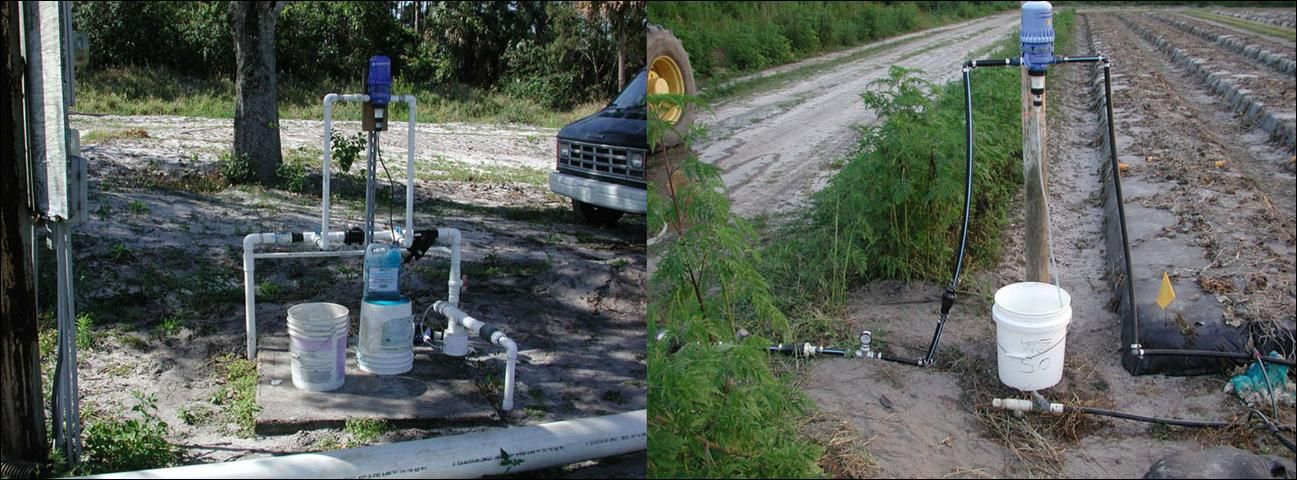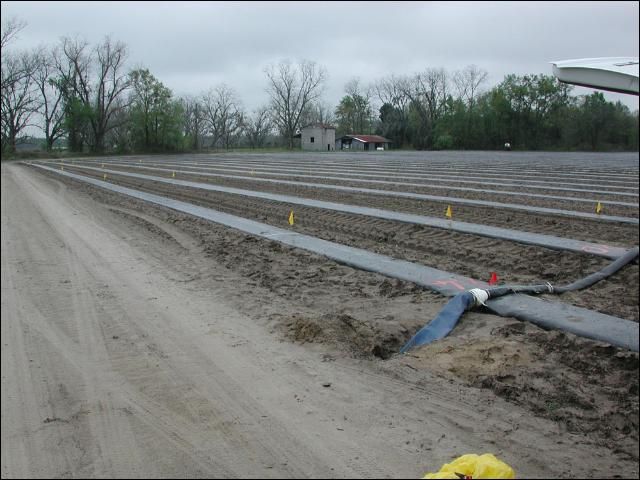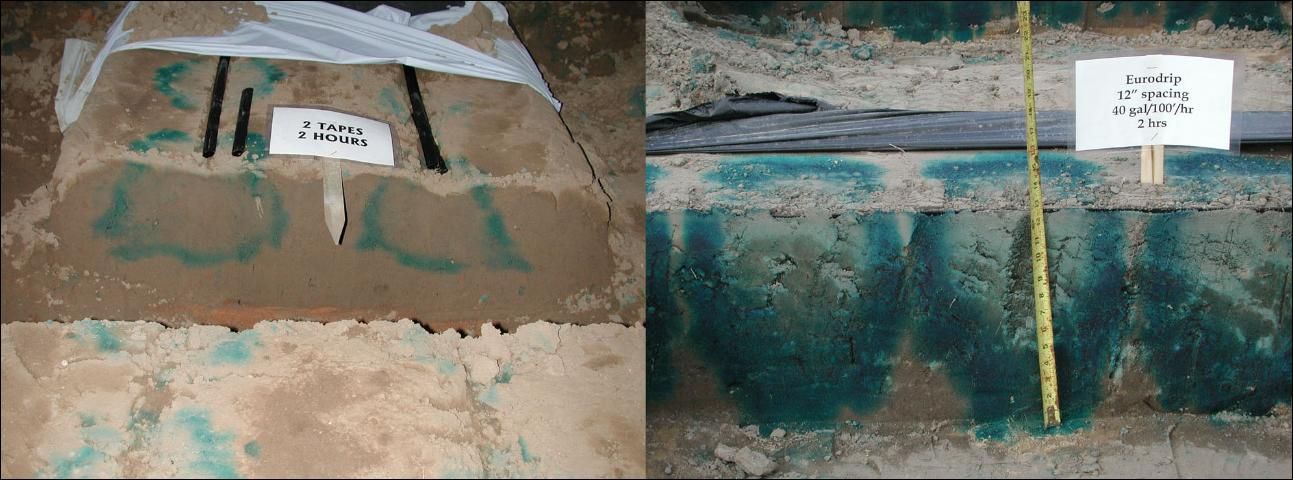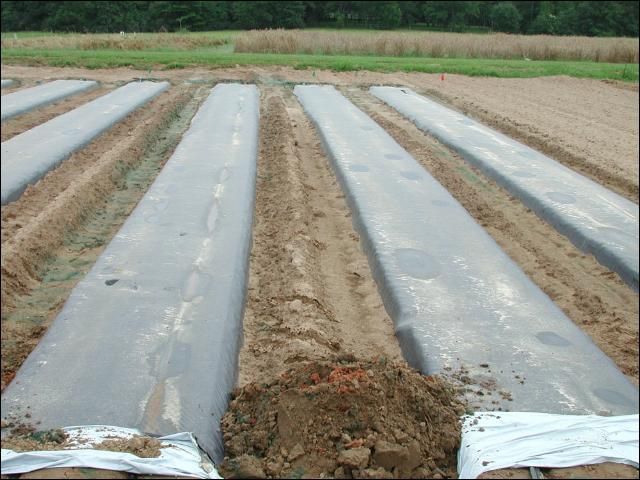Improving irrigation management in vegetable crop production reduces production costs, saves water, and reduces the risk of nutrient leaching. As water movement in the root zone below mulched beds is difficult to see, injecting soluble dye through the drip irrigation system provides a simple and practical method to visualize water movement in the soil. Understanding water movement in raised beds is essential for improving irrigation scheduling and nutrient delivery. Proper irrigation scheduling requires a target irrigation volume, a measure of soil moisture, knowledge of how much water the root zone can hold, and a method to account for rainfall contribution to replenishing soil moisture. By showing how deep and how wide water moves in mulched beds as irrigation volume increases, dye tests are practical tools for determining how much water can be held in the root zone. This information is then used to determine how to split irrigation events and better manage irrigation.
Besides irrigation volume (determined by drip tape flow rate, system pressure and operating time), several factors may affect water movement in mulched beds. These include soil texture, soil organic matter content, bed compaction and/or width, and soil depth and/or the presence of an impermeable layer. Hence, it is not always possible to apply results of a dye test performed under one set of conditions to another field with different conditions. Therefore, on-farm dye tests should be performed to gain a specific understanding of water movement in that field. The objectives of this article are to (1) describe simple and practical step-by-step procedures to adequately conduct an on-farm dye test, (2) provide instructions for data collection and interpretation and (3) to introduce this method to county Extension faculty, students interested in crop production, growers, certified crop advisors, crop consultants, consumers, environmentalists, and policy makers in the agricultural sector for better water savings and environmental sustainability.
Procedures for Conducting a Dye Test
A dye test requires meticulous planning and preparation (steps 1 to 7 in Table 1). It is important to conduct the dye test under conditions like actual production conditions so that water movements observed after the dye test are representative of those occurring during crop production. Since water volumes applied are a function of irrigation time and drip tape flow rate, it may be useful to select and test more than one drip tape type (manufacturer, emitter spacing, and flow rate) and use 1 or 2 drip tapes on each bed. Irrigation times should be selected to cover the range of typical irrigation times used during the crop cycle. It is essential to realize that although irrigation time and irrigation volume are often used interchangeably (rightfully so for a known flow rate), the movement of the waterfront depends on irrigation volume applied (in gallons/100 linear-bed feet), not irrigation time itself. The existing drip irrigation system may need to be modified so only a small area of the field is used for the dye test (Table 2).
For practical purposes, the dye field will be divided into beds (where different drip tapes will be used). Each bed will also be divided into sections corresponding to each of the irrigation times selected (Figure 1). Dye selection (step 5, Table 1) is a critical step. Since the interpretation of the dye test assumes that the dye moves with the waterfront, selected dye should be totally soluble and not adsorbed by soil particles or soil organic matter. On the day of the dye test (steps 8 to 12, Table 1), consider starting early so that the entire test may be conducted during the same day. Once the system is operating, inject the dye and tie the drip tapes at the pre-determined times. Dye may be injected with a Dosatron or Mazzi injector. The shortest irrigation times will be located away from the water source, and increasingly longer irrigation times will be closer to the water source (Figure 2).

Credit: Eric Simonne, UF/IFAS

Credit: Eric Simonne, UF/IFAS
Pressure monitoring during the dye test is important, especially each time a section is tied off. As time progresses, the length of the remaining drip tape is shortened in the irrigation system, which may result in increased pressure and water flow. Volumes delivered by the drip system should be monitored according to operating time and/or with the water meter (Table 2). Pressure and water flow should be kept as constant as possible during the entire test to ensure that operating conditions match those recommended by manufacturers.
Data Collection and Observation of the Dye Pattern
After the dye test, longitudinal and transverse sections should be carefully dug for each drip tape and each operating time (step 13, Table 1). This may be the most time-consuming step. Each dye pattern will appear as a blue ring below each emitter (Figure 3). The dye pattern may appear faded immediately after digging. However, the contrast between the colored areas and the remaining soil will improve as the bed dries out. When dye is injected during the entire test, all the wetted area is colored in blue. Observe the shape of the wetted zone (Figure 4): is it round or elongated? Did the dye move outside the bed? When did emitter-to-emitter coverage occur? When did the dye pass below the root zone (12 inches)? When did the dye reach the impermeable layer? How did the water move then? What is the size and shape of the wetted zone under typical irrigation times?

Credit: Eric Simonne, UF/IFAS

Credit: Eric Simonne, UF/IFAS
After observation, measurements of length, depth and width of the wetted zone should be carefully made (step 14, Table 1) and recorded (Table 3). Pictures may also be taken to provide a permanent record of the dye test.
Using Dye Movement Information for Improving Irrigation Management
While observation provides qualitative information, quantitative measures are needed to improve irrigation management. Important wetting characteristics are maximum wetted width, shortest time (or volume) needed for emitter-to-emitter coverage, and time (or volume) when water reaches the bottom of the root zone (Table 4). Each irrigation event must be a compromise between providing moisture to the crop and minimizing off-site water movement.
Sample data collection form for recording the effect of drip tape and irrigation length on water movement.